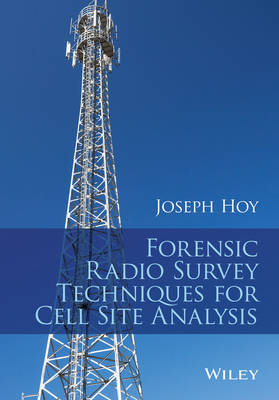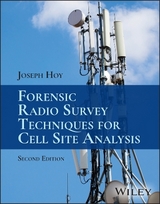
Forensic Radio Survey Techniques for Cell Site Analysis
John Wiley & Sons Inc (Verlag)
978-1-118-92573-7 (ISBN)
- Titel erscheint in neuer Auflage
- Artikel merken
Joseph Hoy is a telecoms engineer and trainer with 27 years of industry experience. He has worked extensively as a forensic cell site analyst and expert witness, contributing to many high-profile cases. He has undertaken the work of the forensic radio surveyor, capturing measurements of cellular coverage at crime scenes and other locations, and has also provided extensive training for cellular engineers, cell site analysts and forensic radio survey engineers.
About the Author xvii
Preface xix
Acknowledgements xxi
Glossary xxiii
1 Forensic Radio Surveys for Cell Site Analysis 1
1.1 Cell Site Analysis 1
1.2 Forensic Radio Surveying 1
2 Radio Theory 3
2.1 RF Propagation 3
2.2 Carrying Information on a Radio Signal 10
2.3 Radio Spectrum 13
2.4 RF Measurements 16
Note 23
References 23
3 Wireless Technologies and Deployments 25
3.1 Coordinating Cellular Development 25
3.2 Evolution from 0G to 4G 26
3.3 3GPP Network Types 30
3.4 3GPP2 Network Types 31
3.5 Other Types of Network 32
3.6 Deployed Technologies by Region 34
3.7 Commonly-used Frequency Bands by Region 36
References 36
4 Cellular Theory 37
4.1 Pre-cellular Radiotelephone Networks 37
4.2 Radio Cells 38
4.3 Frequency Reuse 40
4.4 Cell Size and Coverage 41
4.5 Duplex Techniques 43
4.6 Multiple Access Techniques 44
4.7 Generic Network Architecture 46
4.8 Mobile Devices 47
4.9 Radio Access Networks 48
4.10 Core Networks 51
4.11 Subscriber and Device Identifiers 52
4.12 Network Databases 57
4.13 Cell Sites 59
4.14 Antennas and Azimuths 66
4.15 Uptilt and Downtilt 68
4.16 Cell Types and Sizes 69
4.17 Cell Site Types and Uses 70
4.18 Single and Multi Frequency Networks 71
4.19 Cell Coverage Concepts 74
4.20 Small Cells and Closed Subscriber Groups 77
4.21 Network Activities 78
4.22 Idle Mode and Connected Mode 83
4.23 Cell Access Control 87
4.24 Location Updating (Idle Mode Mobility) 89
4.25 Handover (Connected Mode Mobility) 91
References 92
5 3GPP Network Types 93
5.1 2G GSM Networks 94
5.2 3G UMTS/HSPA Networks 111
5.3 4G LTE Networks 130
References 146
6 Other Cellular Network Types 149
6.1 2G IS-95/cdmaOne 149
6.2 3G IS-2000/CDMA2000 1xRTT 150
6.3 3g Cdma2000 Ev-do 163
6.4 Surveying Other Technologies 165
References 173
7 Forensic Radio Surveys 175
7.1 Forensic Radio Survey Objectives 175
7.2 Forensic Radio Survey Terminology 175
7.3 Forensic Radio Survey Types and Techniques 176
7.4 Idle Mode versus Connected Mode Surveys 187
7.5 Additional Survey Techniques 196
7.6 Survey Preparation 201
7.7 Typical Survey Actions and Procedures 205
7.8 Survey Results: Checking and Confirmation 217
7.9 Survey Notes and Progress Maps 220
7.10 Survey Equipment Types 221
7.11 Raw Survey Results 225
7.12 Processing Survey Results 230
7.13 Understanding Survey Results 239
7.14 Storage of Survey Data 245
7.15 Quality and Best Practice 248
7.16 Summary of Typical Survey Results 252
References 254
8 Cell Site Analysis 255
8.1 Cell Site Concepts 256
8.2 Uses and Limitations of Cell Site Evidence 257
8.3 Regulation of Cell Site Analysis 264
8.4 Components of Cell Site Analysis 265
8.5 Call Detail Records 265
8.6 Sources of Cellular Coverage Data 276
8.7 Forensic Radio Surveys 278
8.8 Cell Site Reports 279
8.9 Call Schedules 285
8.10 Maps and Graphics 286
8.11 Report Checking and Peer Review 289
8.12 Professional and Expert Witnesses 290
8.13 Court Presentations 293
References 296
9 Summary and Practical Activities 297
9.1 Radio and Cellular Concepts 297
9.2 Cellular Identifiers 301
9.3 Cellular Network Types 307
9.4 Forensic Radio Surveys 312
9.5 Survey Results: Checking and Confirmation 321
9.6 Survey Notes and Progress Maps 322
9.7 Survey Results 323
9.8 Cell Site Analysis 330
9.9 End-to-End Process 335
9.10 Master List of Events/Locations 336
9.11 Source Files Attribution List 336
9.12 Normalise Call Data into a Standard Format 337
9.13 Create a Master Cell List 344
9.14 Creating a Case Master Map 345
9.15 Compile Radio Survey Summary Tables 347
9.16 Creating Call and Cell Labels 355
9.17 Cell Site Mapping Presentations 358
9.18 Summary 360
References 361
Index 363
| Erscheint lt. Verlag | 13.2.2015 |
|---|---|
| Verlagsort | New York |
| Sprache | englisch |
| Maße | 178 x 252 mm |
| Gewicht | 762 g |
| Themenwelt | Naturwissenschaften ► Chemie ► Analytische Chemie |
| Technik ► Elektrotechnik / Energietechnik | |
| Technik ► Nachrichtentechnik | |
| ISBN-10 | 1-118-92573-4 / 1118925734 |
| ISBN-13 | 978-1-118-92573-7 / 9781118925737 |
| Zustand | Neuware |
| Informationen gemäß Produktsicherheitsverordnung (GPSR) | |
| Haben Sie eine Frage zum Produkt? |
aus dem Bereich



